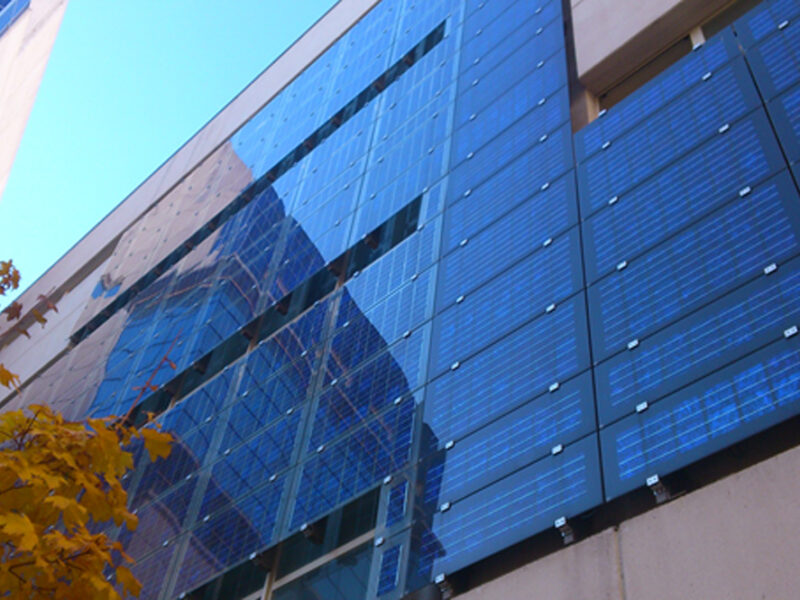
At the tipping point of a new energy era
In the years up to 2035, the residential and industrial demand for electricity will keep on growing, especially if heating with gas and oil is phased out and replaced by electricity. In addition, in countries like Belgium, nuclear energy plants will no longer be part of the energy mix. Wind and solar energy will have to fill a large share of the gap. According to recent studies, there is enough potential to do so. But to make this reality, wind and solar energy generation will have to grow tremendously. In tandem, the usage efficiency of electricity will be improved, with buildings insulated to be energy-neutral, heating provided by heat pumps and heating grids, building-integrated photovoltaics, smarter micro- and nanogrids running on DC, and mass energy storage.
Cheaper than alternatives
The cost of electricity from solar panels has already gone down tremendously over the past years, and it is expected that it will be further reduced leading up to 2035. That will eventually and in most circumstances make solar energy more cost-efficient compared to other forms of electricity generation, even in countries where the sun doesn’t always shine abundantly. The cost comparison will be even more positive when we take into account that carbon-based electricity generation will become progressively more expensive due to carbon taxing schemes.
If we look at the cost of a typical solar installation today, less than half of the price is subsumed by the actual panels. The rest is made up by the electronics, support frames, cabling, and the manual labor – the so-called balance-of-system costs (BOS). The potential to further optimize the BOS costs is limited. So the most obvious way to make a solar installation more cost-efficient is to have it generate more electricity than it does today, mainly by improving the conversion efficiency and energy yield of the solar cells and modules.
Today, conversion efficiencies for commercial silicon solar cells are around 22%, and the best lab result is 25.3%. The physical limit of what can be achieved sits around 30%, so there is still some leeway to improve cells. But as we close in on the limit, the techniques and materials used will become more expensive, seriously eating into the cost gains. Therefore, imec, partner in EnergyVille, also pursues a number of alternative paths to increase the efficiency of solar panels.
One way is to top the silicon solar cells with an additional light-sensitive layer in another material – a second solar cell. An obvious requirement for these so-called tandem cells is that the material on top is transparent to the light that it doesn’t convert. And an additional boost is given if the materials in the stack are sensitive to a distinct part of the light spectrum, so that they don’t scavenge on each other’s conversion potential. The material that captures the shortest wavelengths (e.g. blue and green) will be on top, while the bottom material converts the longer wavelengths (e.g. red and near-infrared).
That way and using a top layer made from Perovskite crystals, imec has already fabricated small solar cells surpassing 27% efficiency. For 2035, we envision large, long-lasting cells with an efficiency of up to 35%.
In addition to tandem cells, imec’s scientists have looked at a number of other techniques to further boost PV efficiency. Bifacial solar cells, for example, capture light on both sides of the cells. They can be used in large-scale installations where the front-side of the panels is directed to the sun, but where the backside also captures some light that is reflected from the ground. Another technique involves alternative, even dynamic reconfigurations of the solar cells in panels. That way, they can be made less vulnerable to shading, e.g. from the blades of nearby windmills

building with PV-enhanced facade panels
(credit Hanjin, creative commons licence)
Integrate solar everywhere
The other half of the cost equation of a solar panel – the BOS costs – are at first sight more difficult to compress. But there is a way out that at the same time opens up a whole new domain for sustainable energy generation. One that we envision will be huge in 2035.
Most modern offices, public buildings and warehouses are clad with large, prefabricated panels, made of glass or opaque materials. These have a number of functions: they form the outer, protective shell, the insulating layer, and they also determine the aesthetics of the building. But what if we’d add an additional function: generating solar energy? This would not be by mounting standard solar modules, which would add to the cost and servicing instead of slashing BOS costs. What we are looking for instead are facade panels with integrated solar cells, panels that can be fabricated flexibly and cost-efficiently in a wide range of looks, shapes, and yields.
Imec and KU Leuven are currently running test setups within the EnergyVille collaboration. We are also looking into the industrial processes that would allow automatic manufacturing of panels directly from the architecture drawings. Seeing that silicon cells may impose some restrictions on the form and transparency of the panels, we also see a great case for thin-film solar cells, another technology that imec has been developing in the frame of Solliance. Thin-film cells will likely not be as efficient as silicon cells, but they can be made extremely thin, partially transparent or colored, on large sheets in flexible formats, even in bended, twisted forms.
Smarter grids, with storage
In 2035, our electricity grid will be much smarter than it is now. It will consist of collections of nested subnets with at the core the nanogrids of individual buildings, offices, public buildings, and houses. These will be subsumed in microgrids, taking in neighboring buildings to form one electricity district. These separate grids will operate as autonomously as possible. They will generate most of the electricity they need and take care not to overload the connecting networks, so these don’t have to be overdimensioned. As energy generation, storage and many of today’s appliances run on DC current, the nanogrids will transport DC and only convert it to AC when necessary, avoiding much of the losses of today’s AC/DC conversion.
Nevertheless, there will be a need for storage, so that energy generated on a sunny day can be used at night, or when it’s gray and raining. Engineers foresee storage at house level – residential storage – but also at district level and higher up. Residential and district storage should be compact, so it will probably be composed of improved lithium-ion technology.
The cost of such batteries today is coming down fast, and is projected to eventually dip below 100 euros per kilowatt-hour by 2035. That will enable home storage solutions of 10 kilowatt-hour at around 1,000 euros. However, homes and districts will have another form of storage available, and that’s the electric vehicles that by 2035 may have power packs of 100 kilowatt-hour. As these vehicles will often be idle, charged and ready, they can be used to power home appliances while making sure at the same time that they still have sufficient energy left to drive.
In 2035, Europe will be on the path of becoming climate neutral by 2050, a goal that was recently set. This means that greenhouse emissions such as CO2 will be largely curbed by powering much of our society with electricity generated from non-fossil fuel sources such as solar, wind, and nuclear sources – a goal that is technically and practically feasible but requires a huge investment and accelerated adoption.
By 2050, what remains of greenhouse gasses, from industrial processes and farming, will eventually have to be compensated through carbon capture and utilization technologies, taking into account that the net CO2-emissions have to become negative.
What is imec doing?
Imec, as EnergyVille partner, works on enabling and improving a number of technologies that may become key in the energy transition. With their 30+ years of expertise, they contribute to the improvement of PV efficiencies, concentrating on the total cost of electricity generated by solar technologies and finding solutions that are industry-compatible.
Imec’s researchers tackle the conversion efficiency of silicon solar cells, looking at a number of alternative architectures such as back-contacted cells, bifacial cells, and tandem cells (silicon or CIGS cells topped with a thin-film PV layer made from perovskite crystals). They’re also involved in fundamental material’s research to boost the reliability and lifetime of thin-film PV technologies. On the level of the standard PV panels, imec looks into better ways to configure cells in a panel, so as to lose less efficiency because of shadows. Looking further ahead, imec’s scientists strive to enable the flexible fabrication of façade panels.

to make next-generation Li-ion batteries for electrical
vehicles and residential storage (artist impression).
Looking at storage, imec is laying the foundation for a much-improved battery technology with a higher energy density and faster charging times. A first result is a potential and promising material to serve at a solid-state electrolyte. But further out, the R&D center also works on architectures with smaller, coated electrode particles, leveraging its unique expertise in nanomaterials, thin-films and interfaces.
About the author:
Bart Onsia is business development manager for imec’s solid state battery and thin-film PV research – www.imec-int.com
 If you enjoyed this article, you will like the following ones: don't miss them by subscribing to :
eeNews on Google News
If you enjoyed this article, you will like the following ones: don't miss them by subscribing to :
eeNews on Google News




